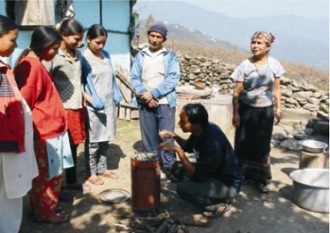Cheapest way to cook, September 09, 2009
Sunita Devi and Ane Nauklivou demonstrate the new smokeless stove at Vatuwaqa yesterday. It’s said to be a more environment friendly way and the cheapest to cook food.
And the plan is for the bio-mass smokeless cooking stoves made out of recycled cylinders — to take over in communities that use open fires for cooking. The stoves use sawdust and dry wood or sticks and came out of a partnership between the Secretariat of the Pacific Community’s FACT project team (Facilitating Agricultural Commodity Trade) and FRIENDS (Foundation for Rural Integrated Enterprises N Development).
The two stoves were tested at Dhirendra Sharma’s business house ‘On Time Engineering’ in Vatuwaqa yesterday.
FACT project member John Bennet said the two stoves used discarded recycled cylinders which would otherwise be sent abroad for recycling or discarded along with garbage.
“The shipment of these cylinders is an effective measure to control pollution but it is expensive. So we have designed it in such a way that could serve a useful purpose locally and benefit the environment as well,” Mr Bennet said.
“We need to start using measures that reduces pollution and decreases the risk of damaging the ozone layer.” It took two days for Sunita Devi, the engineering supervisor to patch up the metals into a stove. The broader and larger stove of the two stoves called the wood-bio-mass burner, Mr Bennet said, used dry leaves, wood, sticks and coconut husks to create fire.
The slimmer stove called saw-dust burner used saw dust. Mr Sharma said one whole compressed set of saw dust could prepare meals for three days.
“Saw dust doesn’t cost at all and what makes it more interesting is that gives out no smoke, so there are no chances of coughing, or the pot getting black or damaging the ozone layer.”
“Imagine the amount of cooking that can be saved and money on buying kerosene,” Mr Sharma said.
The stoves also have mechanisms to control heat and turning the fire out. The group was successful in boiling dalo on the saw dust burner and water on the wood-bio-mass burner.



